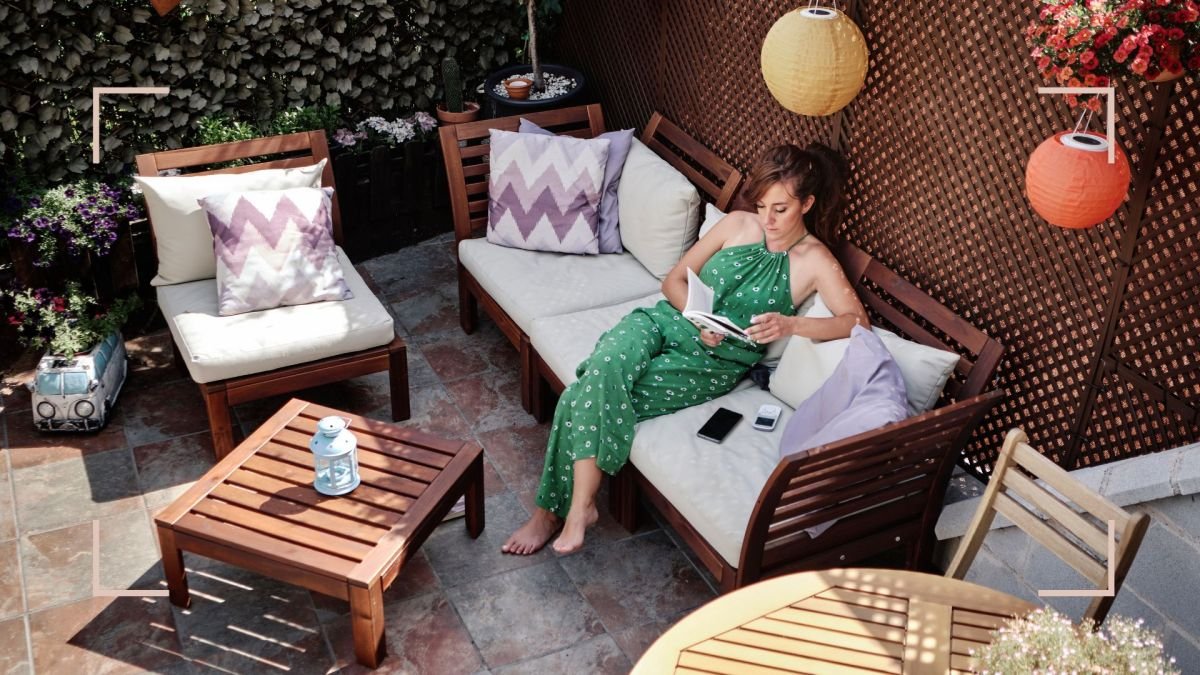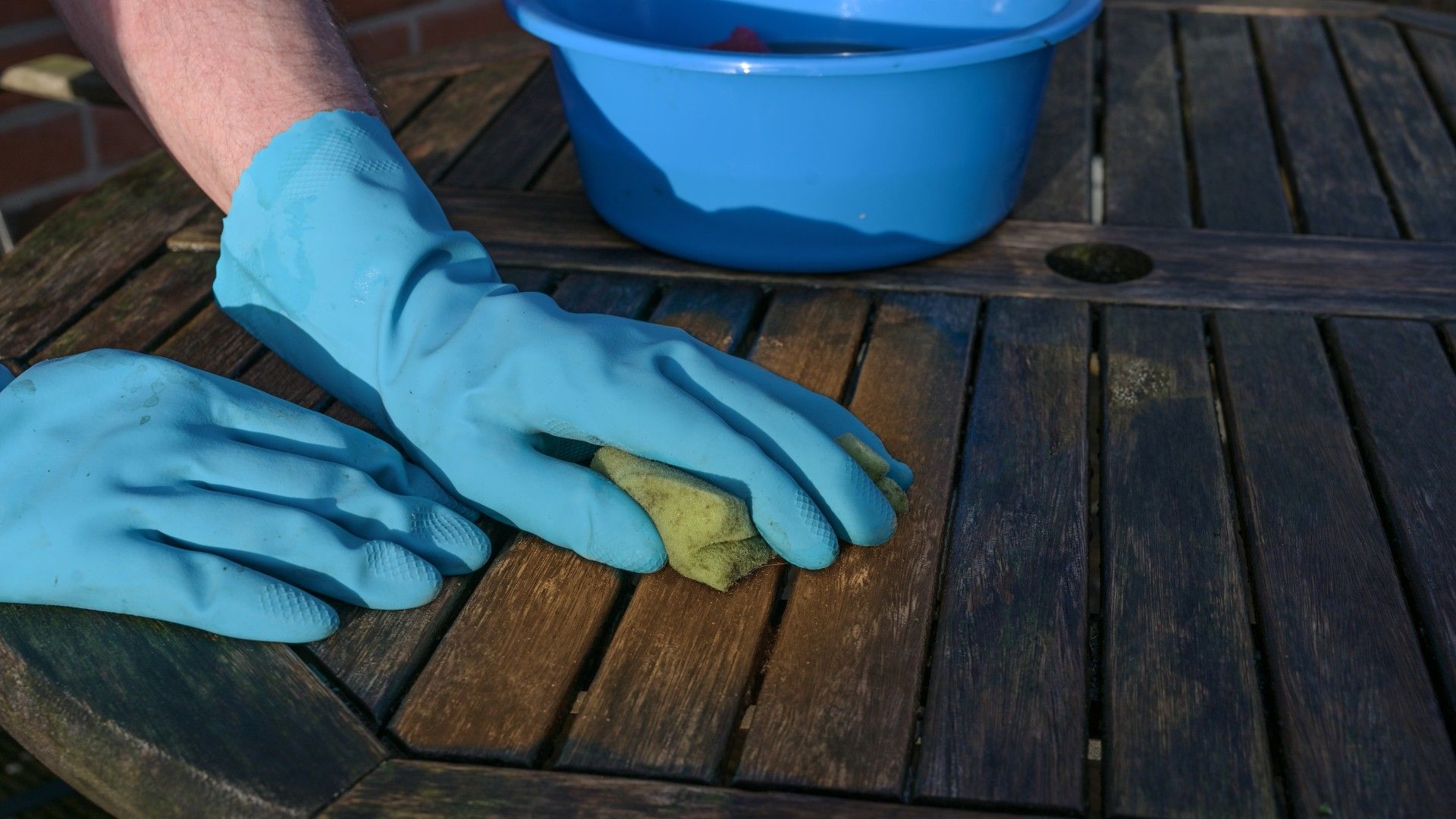
[ad_1]
With summer around the corner, it’s time to spruce up the backyard ready for outdoor enjoyment and that includes your outdoor furniture. When it comes to how to clean wooden garden furniture, luckily, it’s a fairly simple task.
Cleaning your best outdoor furniture, along with cleaning your decking and giving the grass its first cut of the year, is essential to make sure your outdoor space is in tip-top condition ahead of hosting a BBQ or throwing a garden party.
While it might seem like a daunting task because of the potential risk of damaging the wood, thankfully, cleaning wooden garden furniture is actually quite a simple chore – especially with a little help from experts.
This expert guide will look at how to clean your wooden garden furniture properly, without causing any damage to the wood.
How to clean wooden garden furniture
It’s important to know how to clean your wooden garden furniture properly, so we’ve spoken to experts to find out how it should be done correctly.
“Many people invest in quality pieces when shopping for wooden garden furniture because it lasts longer. However, that won’t be the case if you don’t provide it with the required maintenance and care,” explains Lily Cameron, a cleaning expert at professional cleaning company, Fantastic Services.
“Outdoor furniture cleaning is actually one of the most neglected tasks when homeowners start preparing their houses for the warmer weather. Cleaning it isn’t actually complicated and, besides extending your pieces’ lifespan, it can also help you better enhance your outdoor seating area.”
Here’s what you will need:
- Bucket of warm water
- Mild soap
- Soft-bristle brush
- Cloth
- Sponge
- Sander or sand paper (optional)
- Hose (optional)
- Wooden stain, paint or protective treatment
1. Clear the area
Similar to how you would declutter your home prior to cleaning a room, before you can begin cleaning your wooden garden furniture, you need to make sure you work space is clear.
Any objects or furniture near your workspace are just going to get in your way, so remove them from the area to ensure maximum cleaning potential. If your garden furniture is on your decking, it might be an idea to move them onto a grass area so you don’t get any dirt or mess on your decking.
Lily says, “Start by clearing the area around the furniture to provide enough space for comfortable work. If there are any cushions or accessories on the furniture, remove them as well.”

(Image credit: Getty)
2. Remove any debris
Once the area is clear, it’s now time to remove large bits of debris, such as leaves, and get rid of dust that has built up over the winter months, to get your wooden furniture ready for a wet clean.
“Use a soft-bristle brush or a dry cloth to gently remove any loose dirt, dust, or other particles from the surface of the wooden furniture,” advises Lily. “Pay special attention to corners, crevices, and any intricate designs.” Crevices and grooves are places where material can gather and begin to rot your wooden furniture, and it’s better to be safe than sorry.
This step ensures your wooden garden furniture is completely clear of loose dirt before adding any wet cleaning solutions – to avoid potential staining and prevent any buildup of algae.
3. Wash with soapy water
Now you’ve removed any loose bits of dirt and debris, your wooden garden furniture is ready to be properly cleaned.
For this step, grab your bucket and fill it with warm water mixed with soap or a mild washing-up liquid. You can also use a wood cleaner, but this isn’t necessary.
“Start your cleaning regime gently with some warm soapy water and a damp cloth or sponge to loosen up any dirt and grime,” suggests Deirdre McGettrick, co-founder and CEO of ufurnish.com. “Using a damp cloth ensures you’re not soaking your wooden furniture – and be sure to rinse the cloth regularly.”
Lily adds, “Scrub the wooden surface in circular motions, focusing on stubborn stains. But avoid using harsh chemicals or abrasive cleaners because they can damage the wood surfaces.”
It’s also an idea to test the cleaning solution on a small area first, to make sure you don’t cause any damage or discoloration to the wood.

(Image credit: Getty)
4. Rinse and dry
Once the wooden garden furniture is clean, you need to rinse the items with clean water to get rid of any soap residue.
Lily explains, “After cleaning, rinse the furniture thoroughly with clean water to remove any remaining soap residue. You can either use a garden hose or a bucket of water for this step, but make sure that all soap is completely washed away.”
Then you need to let your furniture dry. Wooden garden furniture has a tendency to warp and become misshapen over time, so this step is crucial – like when cleaning wooden spoons or cleaning hardwood floors, the same principles apply.
Lily says, “Allow the wooden furniture to air dry in a shaded area and avoid placing it under direct sunlight because it can lead to warping or cracking. Make sure the furniture is completely dry before moving to the next step.”
5. Sand away stubborn dirt
Once your wooden garden furniture is dry, if there are any stubborn dirt spots that haven’t budged, you can lightly sand them away. Always take care not to damage the wooden surface during this process.
Deirdre says, “Now that you’ve removed the easy-to-remove dirt and grime, it’s time to get a bit tougher and sand away anything that couldn’t be removed with a cloth and some elbow grease. Be very careful though and only use gentle sanding.”
While garden furniture expert Steve Chilton from LeisureBenchadds, “Lightly sand the surface of the wood removing any tough grime and creating an even texture. Rinse any excess dust using a light pressure hose, making sure to avoid using a pressure washer as this can damage the furniture.”

(Image credit: Getty)
6. Stain and treat
After all that hard work cleaning, you want to add a layer of protection to your wooden garden furniture to keep it looking clean and fresh all summer long and protect it from any harsh weather.
“Now that all traces of dirt and grime have been removed, it’s time to add a protective layer to your wood furniture,” says Deirdre. “You have numerous options when it comes to protecting your furniture and you can choose from paint, oils, or stains. When choosing your protection be sure to patch test an inconspicuous area to make sure you like it and that it suits your piece of furniture and garden.”
While Lily adds, “Opt for a product specifically designed for outdoor wooden furniture and follow the manufacturer’s instructions for application.”
How do you remove grime from outdoor furniture?
Removing grime from outdoor furniture is a relatively simple task and can be achieved by following the steps above, with some small tweaks.
“Grime and dirt can easily build up on outdoor furniture, especially if it is left outside throughout the winter months,” says Steve, in an outdoor living room for instance. “In order to remove this buildup start by trying a chemical-free and gentle approach using mild soapy water and a sponge. With a bit of elbow grease, this will help remove grime without risking any damage to the furniture.”
He adds, “However, tough grime can sometimes prove difficult to tackle so a harsher approach may be necessary. If this is the case try using a store-bought wooden furniture cleaner, if any grime remains, try lightly sanding these areas down. In addition, to prevent this build-up of grime altogether try maintaining your furniture year round by storing it somewhere undercover during the winter months and wiping down the surface regularly with a damp cloth.”
And Astonish’s Cleaning Chemist, Olivia Young, advises, “I recommend washing the furniture with a warm soapy solution. However, for those chairs or tables that may have a thicker layer of grime, brushing away any stubborn residue with a strong brush before soaking can speed up the process.”
How do you clean wood furniture without removing the finish?
Steering clear of harsh chemicals such as bleach and ammonia is the best way to ensure that you don’t remove the finish while cleaning your wooden garden furniture.
Lily says, “Cleaning wood furniture without removing the finish requires a gentle approach to prevent damage. Use a soft, lint-free cloth or a feather duster when dusting to remove any loose grime. Besides that, it’s advisable to opt for a mild soap solution made with non-abrasive cleaners and avoid harsh chemicals that can strip or damage the finish.”
She adds, “Before applying any cleaning solution to the entire furniture piece, make sure to also spot-test it on a small area to check for any adverse reactions that can damage the finish. It’s also very important to avoid excessive moisture or scrubbing, as it can damage the furniture’s finish.”
You also need to know whether your wooden garden furniture is waxed or not before you start cleaning. Dierdre says, “A large proportion of outdoor wood furniture is sealed with wax to increase its durability. This is an important consideration when cleaning your wood furniture as you don’t want to remove the finish.
“The safest and most effective way to clean your wood furniture is mixing a weak solution of dish soap and water applied with some elbow grease and a damp cloth. Make sure you don’t saturate the wood and rinse your cloth often.”
Is it OK to clean wood furniture with vinegar?
As vinegar is highly acidic, cleaning with vinegar when cleaning your wooden garden furniture could cause damage. While in most cases you can use diluted vinegar to clean your wooden furniture, precautions must be taken and some experts advise against using it.
Lily warns, “Keep in mind that while vinegar can help remove certain stains or grime from wooden furniture, it may not be suitable for all types of finishes. Some finishes, such as shellac or lacquer, can be sensitive to such acidic solutions. Before you use it, it’s advisable to consult the manufacturer’s recommendations or seek professional advice.”

(Image credit: Getty)
You also need to make sure you highly dilute the vinegar with water to prevent damaging your wooden garden furniture. Steve says, “Vinegar is an easily accessible household item that is great for cleaning any stains or mildew from wooden furniture. However, ensure that you distill this mixture with water otherwise the acidity of the vinegar will damage the wood, this should be roughly diluted on a 1:1 ratio with 1 part vinegar and 1 part warm water.
“In addition, use a soft sponge to gently rub the mixture in, and once the stains and dirt have been targeted make sure to use a damp cloth to remove any excess vinegar mixture. This step is important as leaving the diluted vinegar on the surface for too long could eventually erode the wood.”
And Dierdre says that it all depends on whether your wooden garden furniture is waxed or not. She says, “There are conflicting opinions on the use of vinegar for cleaning wood furniture. Some people are on the side of using diluted vinegar and a soft cloth to clean wood furniture, while others say that vinegar wears away the wax finish on wood furniture and should be avoided.
So, in summary, should you not use vinegar to clean wooden garden furniture? “The answer? We’d recommend avoiding the use of vinegar on waxed wood furniture as continuous use can wear away this finish and leave the wood looking dull and cloudy,” Dierdre concludes. “However, if your wood is of a more rustic finish and not waxed, then the use of diluted vinegar in small quantities can be helpful in keeping your furniture in tip-top shape.”
[ad_2]
Source link






